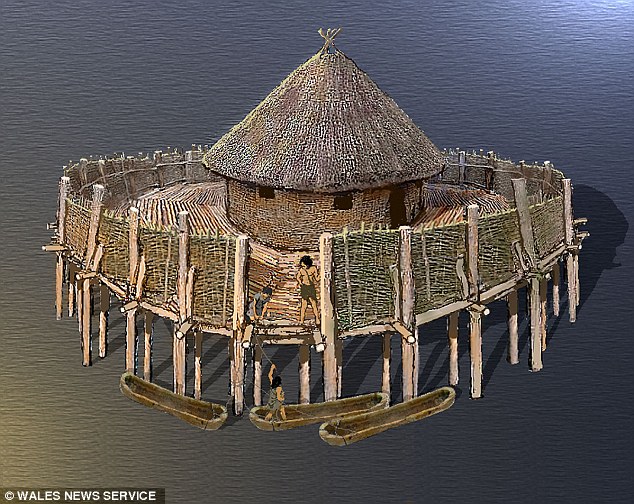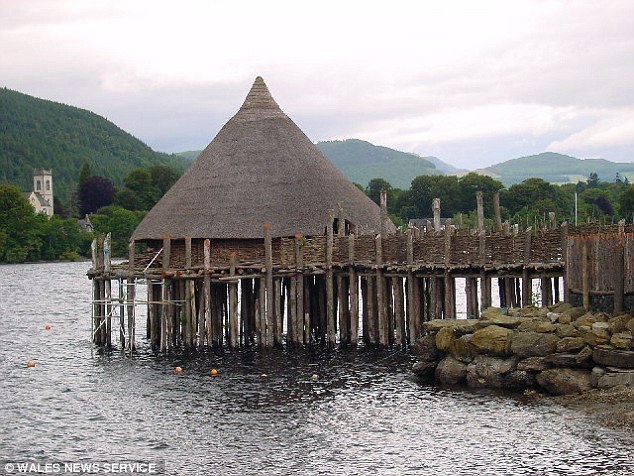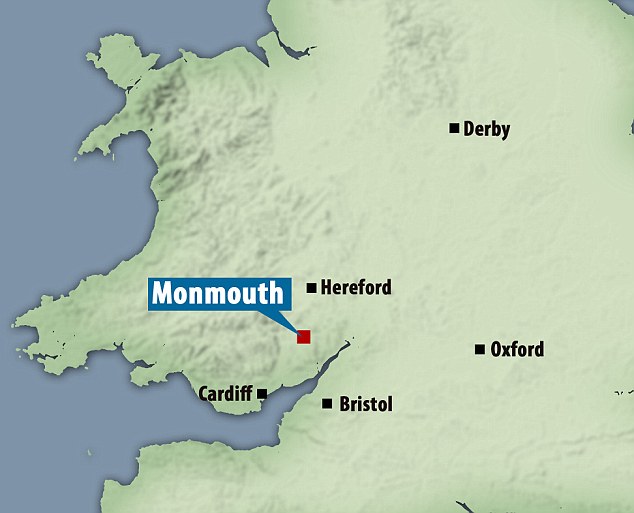An ancient lakeside fortress older than the Pyramids has been uncovered on a new housing estate - and archaeologists believe it is one of the world's oldest known boat building communities.
The wooden fort was built on stilts standing over a long-vanished Ice Age lake 4,900 years ago to defend against marauding tribes.
Radiocarbon dating of the timbers has revealed the fortified farmstead at Monmouth, South Wales, was built in 2917 BC - making it 300 years older than the Pyramids at Giza.
The Neolithic fort on stilts was known as a crannog and was built far from the shore of the lake on a manmade island to make it harder to attack.
It is only the second crannog to be discovered in England and Wales but is older than the only other example on Llangorse Lake in the Brecon Beacons by 2,000 years.
Wooden fortress older than the PYRAMIDS unearthed on housing estate: 'Crannog' built by boat building community dates back almost 5,000 years
Wooden fort was built on stilts standing over a long-vanished Ice Age lake
Built 4,900 years ago to defend community against marauding tribes
Radiocarbon dating of the timbers has revealed the fortified farmstead was built in 2917 BC - making it 300 years older than the Pyramids at Giza
By Jack Millner For Mailonline
21 July 2015
Daily Mail
An ancient lakeside fortress older than the Pyramids has been uncovered on a new housing estate - and archaeologists believe it is one of the world's oldest known boat building communities.
The wooden fort was built on stilts standing over a long-vanished Ice Age lake 4,900 years ago to defend against marauding tribes.
Radiocarbon dating of the timbers has revealed the fortified farmstead at Monmouth, South Wales, was built in 2917 BC - making it 300 years older than the Pyramids at Giza.

Radiocarbon dating of the timbers reveals the fortified farmstead at Monmouth, South Wales, was built in 2917 BC - making it 300 years older than the Pyramids at Giza. The wooden fort was built on stilts standing over a long-vanished Ice Age lake 4,900 years ago to defend against marauding tribes (artist's impression pictured)
The Neolithic fort on stilts was known as a crannog and was built far from the shore of the lake on a manmade island to make it harder to attack.
It is only the second crannog to be discovered in England and Wales but is older than the only other example on Llangorse Lake in the Brecon Beacons by 2,000 years.
Archaeologist Stephen Clarke MBE, who founded Monmouth Archaeology, said: 'This is surely one of the most stunning of prehistoric discoveries.
'An exceptional feature is that the construction was based on three massive parallel 'sleeper beams' - timbers roughly hewn from complete trees set in the ground horizontally.
'One of these timbers is a metre wide and all of them seem to have been from full-grown trees.
'Most of the known long houses were based on posts.'

The wooden fort was built on stilts standing over a long-vanished Ice Age lake 4,900 years ago to defend against marauding tribes. Pictured, example of a crannog on Scotland's Loch Tay
The discovery of the crannog under a building site in Monmouth, South Wales, earmarked for 450 houses paints a picture of a thriving community based around the world's oldest known boat building yards.
The prehistoric boat building site was uncovered in 2013 near the newly-discovered crannog site - and dates back to 1,700 BC.
Excavations revealed three 100ft-long (30m) channels which run parallel to each other and at right angles to the ancient lake.

The discovery of the crannog under a building site in Monmouth, South Wales (pictured) paints a picture of a thriving community based around the world's oldest known boat building yards. The prehistoric boat building site was uncovered in 2013 near the newly-discovered crannog site - and dates back to 1,700 BC
The metre-wide channels were shaped like the bottom of wooden canoes and cut through a mound of burned earth carbon dated to the early Bronze Age.
Mr Clarke said they showed a twin-hulled boat with an outrigger being dragged into a huge Ice Age lake.
He said: 'No one in the world has ever identified a prehistoric boat building site before. They have found fragments of boats but never a boat building site - this is of international importance.

Remains of the crannog timbers (pictured) were preserved beneath the clay and peat of a lagoon which formed when the lake drained some 2,000 years ago. They had been skilfully worked with a stone axe to form the bottom of a stilt supporting structure in the lake bed
'There was no sign of the wooden boat but there was evidence of wood working on the site - with sharp flakes of imported flint found alongside the channels.'
The crannog and outrigger boat were built on what was a 2.5 mile prehistoric lake, home to hunter gatherers before it drained away over thousands of years.
The latest discovery of the crannog has been published in a book called The Lost Lake about the community living on the Monmouth post-glacial lake.
Remains of the crannog timbers were preserved beneath the clay and peat of a lagoon which formed when the lake drained some 2,000 years ago.
They had been skilfully worked with a stone axe to form the bottom of a stilt supporting structure in the lake bed.
Crannogs are believed to have been centres of prosperous farms where people lived in an easily-defended location to protect themselves and their livestock from passing raiders.
There are over 600 recognised crannogs in the lochs of Scotland but most date from the later Iron Age than the Monmouth crannog.
The settlements consisted of a farm house, with cattle and crops being tended in nearby fields, and sheep on hill pastures.
Local woodlands would have serviced the home with fruit, hazelnuts, wild cabbage and medicines, as well as with wild boar and other woodland animals suitable for hunting.
Crannog

The replica crannog on Loch Tay in Scotland
The Irish word crannóg derives from Old Irish crannóc, that referred to a wooden structure or vessel, stemming from crann, which means "tree", plus a diminutive ending—literally "young tree".
Crannogs are widespread in Ireland with an estimated 1,200 examples, while Scotland has 347 sites officially listed as such but probably has over 600 in total.
The Monmouth crannog is only the second crannog to be discovered in England and Wales.
ROMANS AND VIKINGS DIDN'T LEAVE A TRACE ON BRITISH DNA
We like to think of ourselves as being different from our European neighbours.
But the English owe a lot to the French and a fair amount to the Germans – at least as far as our genes are concerned.
For a study has mapped the genetic make-up of Britain. Researchers analysed the genetic code of 2,000 white Britons and compared the results to data on more than 6,000 people from ten European countries.
They found that many of us have DNA that is 45 per cent French in origin while many white Britons are a quarter German.
Surprisingly, given that they invaded and occupied large parts of the British Isles for four centuries, there is little genetic trace of the Romans.
Similarly, the Vikings may have a reputation for rape and pillage but the genetic evidence shows they did not have enough children with the locals for their Danish DNA to be present today.
The Anglo-Saxons, in contrast, did leave a genetic legacy, with about 20 per cent of the DNA of many English people coming from the invaders who arrived 1,600 years ago.
The wooden fort was built on stilts standing over a long-vanished Ice Age lake 4,900 years ago to defend against marauding tribes.
Radiocarbon dating of the timbers has revealed the fortified farmstead at Monmouth, South Wales, was built in 2917 BC - making it 300 years older than the Pyramids at Giza.
The Neolithic fort on stilts was known as a crannog and was built far from the shore of the lake on a manmade island to make it harder to attack.
It is only the second crannog to be discovered in England and Wales but is older than the only other example on Llangorse Lake in the Brecon Beacons by 2,000 years.
Wooden fortress older than the PYRAMIDS unearthed on housing estate: 'Crannog' built by boat building community dates back almost 5,000 years
Wooden fort was built on stilts standing over a long-vanished Ice Age lake
Built 4,900 years ago to defend community against marauding tribes
Radiocarbon dating of the timbers has revealed the fortified farmstead was built in 2917 BC - making it 300 years older than the Pyramids at Giza
By Jack Millner For Mailonline
21 July 2015
Daily Mail
An ancient lakeside fortress older than the Pyramids has been uncovered on a new housing estate - and archaeologists believe it is one of the world's oldest known boat building communities.
The wooden fort was built on stilts standing over a long-vanished Ice Age lake 4,900 years ago to defend against marauding tribes.
Radiocarbon dating of the timbers has revealed the fortified farmstead at Monmouth, South Wales, was built in 2917 BC - making it 300 years older than the Pyramids at Giza.

Radiocarbon dating of the timbers reveals the fortified farmstead at Monmouth, South Wales, was built in 2917 BC - making it 300 years older than the Pyramids at Giza. The wooden fort was built on stilts standing over a long-vanished Ice Age lake 4,900 years ago to defend against marauding tribes (artist's impression pictured)
The Neolithic fort on stilts was known as a crannog and was built far from the shore of the lake on a manmade island to make it harder to attack.
It is only the second crannog to be discovered in England and Wales but is older than the only other example on Llangorse Lake in the Brecon Beacons by 2,000 years.
Archaeologist Stephen Clarke MBE, who founded Monmouth Archaeology, said: 'This is surely one of the most stunning of prehistoric discoveries.
'An exceptional feature is that the construction was based on three massive parallel 'sleeper beams' - timbers roughly hewn from complete trees set in the ground horizontally.
'One of these timbers is a metre wide and all of them seem to have been from full-grown trees.
'Most of the known long houses were based on posts.'

The wooden fort was built on stilts standing over a long-vanished Ice Age lake 4,900 years ago to defend against marauding tribes. Pictured, example of a crannog on Scotland's Loch Tay
The discovery of the crannog under a building site in Monmouth, South Wales, earmarked for 450 houses paints a picture of a thriving community based around the world's oldest known boat building yards.
The prehistoric boat building site was uncovered in 2013 near the newly-discovered crannog site - and dates back to 1,700 BC.
Excavations revealed three 100ft-long (30m) channels which run parallel to each other and at right angles to the ancient lake.

The discovery of the crannog under a building site in Monmouth, South Wales (pictured) paints a picture of a thriving community based around the world's oldest known boat building yards. The prehistoric boat building site was uncovered in 2013 near the newly-discovered crannog site - and dates back to 1,700 BC
The metre-wide channels were shaped like the bottom of wooden canoes and cut through a mound of burned earth carbon dated to the early Bronze Age.
Mr Clarke said they showed a twin-hulled boat with an outrigger being dragged into a huge Ice Age lake.
He said: 'No one in the world has ever identified a prehistoric boat building site before. They have found fragments of boats but never a boat building site - this is of international importance.

Remains of the crannog timbers (pictured) were preserved beneath the clay and peat of a lagoon which formed when the lake drained some 2,000 years ago. They had been skilfully worked with a stone axe to form the bottom of a stilt supporting structure in the lake bed
'There was no sign of the wooden boat but there was evidence of wood working on the site - with sharp flakes of imported flint found alongside the channels.'
The crannog and outrigger boat were built on what was a 2.5 mile prehistoric lake, home to hunter gatherers before it drained away over thousands of years.
The latest discovery of the crannog has been published in a book called The Lost Lake about the community living on the Monmouth post-glacial lake.
Remains of the crannog timbers were preserved beneath the clay and peat of a lagoon which formed when the lake drained some 2,000 years ago.
They had been skilfully worked with a stone axe to form the bottom of a stilt supporting structure in the lake bed.
Crannogs are believed to have been centres of prosperous farms where people lived in an easily-defended location to protect themselves and their livestock from passing raiders.
There are over 600 recognised crannogs in the lochs of Scotland but most date from the later Iron Age than the Monmouth crannog.
The settlements consisted of a farm house, with cattle and crops being tended in nearby fields, and sheep on hill pastures.
Local woodlands would have serviced the home with fruit, hazelnuts, wild cabbage and medicines, as well as with wild boar and other woodland animals suitable for hunting.
Crannog

The replica crannog on Loch Tay in Scotland
The Irish word crannóg derives from Old Irish crannóc, that referred to a wooden structure or vessel, stemming from crann, which means "tree", plus a diminutive ending—literally "young tree".
Crannogs are widespread in Ireland with an estimated 1,200 examples, while Scotland has 347 sites officially listed as such but probably has over 600 in total.
The Monmouth crannog is only the second crannog to be discovered in England and Wales.
ROMANS AND VIKINGS DIDN'T LEAVE A TRACE ON BRITISH DNA
We like to think of ourselves as being different from our European neighbours.
But the English owe a lot to the French and a fair amount to the Germans – at least as far as our genes are concerned.
For a study has mapped the genetic make-up of Britain. Researchers analysed the genetic code of 2,000 white Britons and compared the results to data on more than 6,000 people from ten European countries.
They found that many of us have DNA that is 45 per cent French in origin while many white Britons are a quarter German.
Surprisingly, given that they invaded and occupied large parts of the British Isles for four centuries, there is little genetic trace of the Romans.
Similarly, the Vikings may have a reputation for rape and pillage but the genetic evidence shows they did not have enough children with the locals for their Danish DNA to be present today.
The Anglo-Saxons, in contrast, did leave a genetic legacy, with about 20 per cent of the DNA of many English people coming from the invaders who arrived 1,600 years ago.
Last edited: